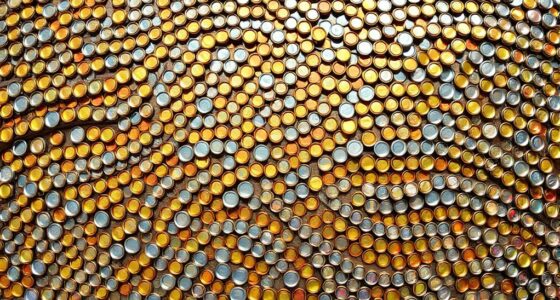Subodh Gupta elevates everyday Indian objects like stainless steel pots, bicycles, and tiffin boxes into striking works of art that reflect social change, tradition, and modernization. His bold sculptures and installations transform routine items into powerful symbols of Indian life, capturing cultural memory and urban transformation. Gupta’s work bridges local traditions with global contemporary art, making the ordinary extraordinary. If you explore further, you’ll discover how his art offers a deep look into India’s evolving identity.
Key Takeaways
- Subodh Gupta transforms ordinary Indian household items like steel pots, tiffin boxes, and bicycles into large-scale, symbolic sculptures.
- His art elevates everyday objects to explore themes of cultural identity, modernization, and social change in India.
- Gupta’s innovative use of materials highlights the textures, histories, and stories embedded in common household items.
- His works blend traditional Indian symbolism with contemporary art, gaining international recognition at venues like Venice Biennale.
- Gupta’s artworks challenge perceptions by turning mundane objects into powerful narratives of Indian life and transformation.
Early Life and Artistic Foundations
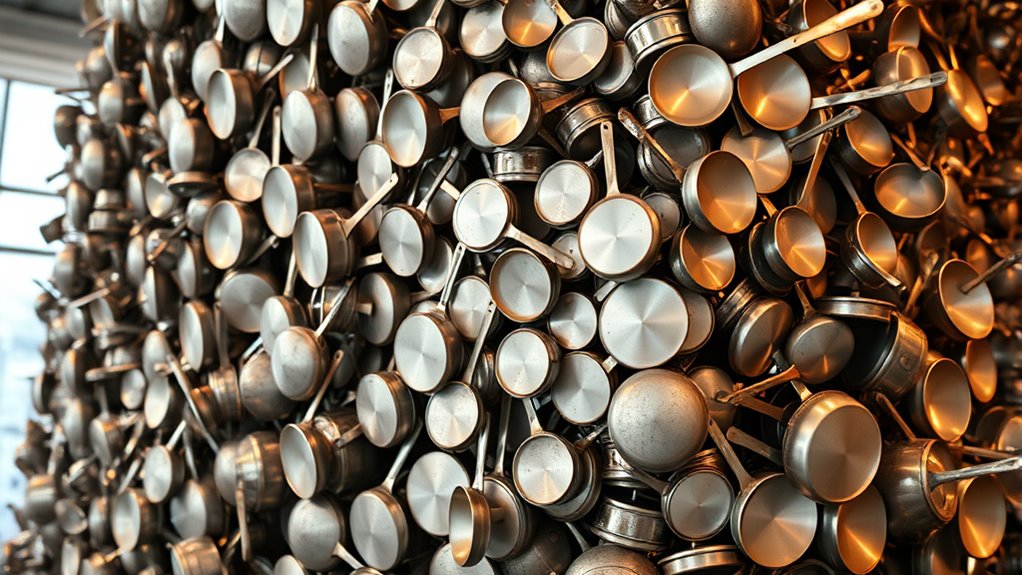
Subodh Gupta was born in Khagaul, Bihar, in 1964, and his early life was shaped by a modest background and a community heavily involved with railway work. His father was a railway guard, and his mother was a homemaker, which meant daily life revolved around the railway networks and associated labor. Growing up in Bihar, one of India’s less developed states, he faced early challenges, including losing his father when he was just 11. These hardships, combined with his community’s strong ties to the railways, deeply influenced his perspective. In 1983, he enrolled at the College of Arts and Crafts in Patna, where he developed an interest in classical Indian art forms. His early experiences laid the foundation for his later artistic exploration of everyday objects and cultural narratives. Additionally, Gupta’s work often draws inspiration from urban environments and the socio-economic realities of Indian life, reflecting his deep connection to his roots. His understanding of everyday objects as carriers of cultural meaning has become a hallmark of his artistic style. He is also known for transforming ordinary items into symbolic artistic expressions that challenge viewers’ perceptions. Moreover, Gupta’s innovative use of traditional materials and techniques helps bridge contemporary art with India’s cultural heritage, a process that is often linked to the blending of traditional and modern influences in global art movements.
The Evolution of Gupta’s Artistic Style
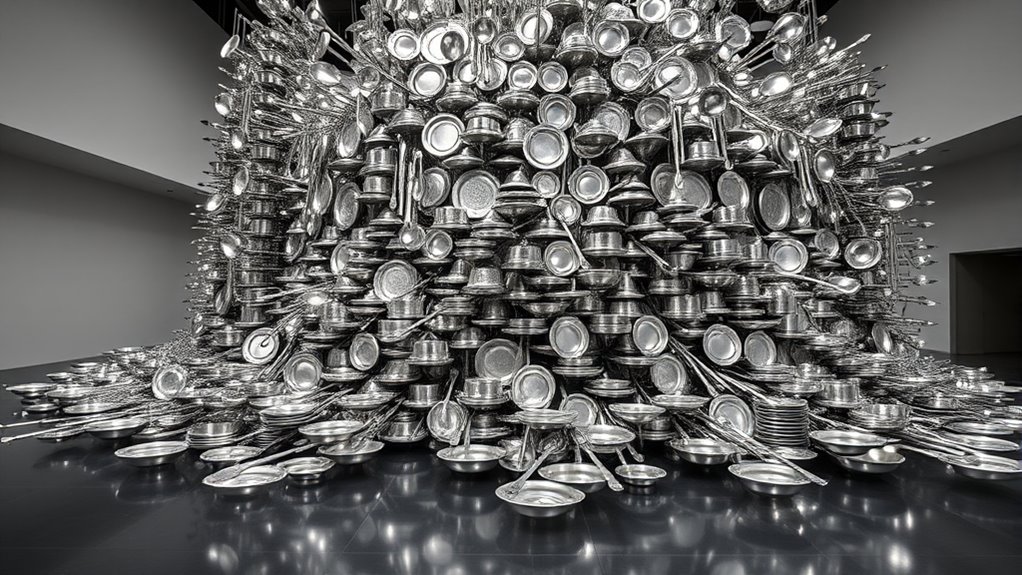
You’ll notice how Gupta evolved from simple gestural abstraction to bold sculptures that use everyday materials. His experimentation with different techniques transformed common objects into powerful symbols of culture and modern life. This evolution highlights how his style reflects both changing artistic practices and deeper cultural meanings. As a leading contemporary art platform in India, his work has gained international recognition and has influenced the broader art scene. Additionally, his innovative use of found objects underscores the significance of materiality in contemporary art practices. His approach exemplifies how materiality can serve as a cultural commentary, enriching the interpretive depth of his work and demonstrating the importance of cultural intelligence in understanding and appreciating diverse artistic expressions. Moreover, Gupta’s ability to elevate everyday objects into iconic artworks exemplifies the power of artistic innovation in shaping cultural narratives. Recognizing the emotional resonance of everyday objects further deepens the viewer’s connection to his art, emphasizing the role of emotional support in engaging with contemporary themes.
Material Transformation Techniques
How do artists reimagine everyday objects to create powerful statements? By transforming materials through innovative techniques that elevate the mundane into meaningful art. Gupta’s approach involves:
- Using diverse, industrial, and discarded materials like steel tiffin boxes, metal drums, and bicycles, turning scraps into sculptures. This approach emphasizes the importance of found objects in contemporary art, allowing artists to comment on societal issues and cultural identity. Incorporating recycled materials underscores the environmental consciousness prevalent in modern artistic practices.
- Manipulating stainless steel sourced from kitchen utensils and everyday items to craft complex, reflective installations.
- Transforming found objects such as street carts, gas canisters, and motorcycles into symbolic sculptures that evoke societal narratives. The selection of appropriate materials is crucial, as it allows the artist to explore themes of modernity and globalization through their transformations.
- The process involves careful consideration of material transformation techniques, which enable artists to reimagine ordinary objects with new meanings and cultural significance. Gupta’s mastery lies in elevating ordinary materials into profound, thought-provoking art.
Cultural Significance Evolution
The evolution of Gupta’s artistic style reflects a dynamic journey from rooted rural traditions to a globally recognized contemporary practice. Born in 1964 in Bihar’s Khagaul, you’re inspired early by Indian customs, rituals, and everyday objects. Moving from gestural painting, you shifted toward sculpture, installation, video, and performance, blending rural iconography with modern mediums. Your work reinterprets traditional symbols—like utensils, bicycles, and cow dung—challenging their sacred or mundane meanings. You monumentalize these objects, highlighting their cultural weight and transforming their significance. By bridging local rituals with universal themes such as migration and consumption, you make Indian cultural narratives accessible worldwide. This evolution elevates ordinary objects into symbols of identity and social change, redefining their place in contemporary art and reshaping perceptions of Indian cultural significance. His international recognition grew alongside his stylistic evolution, which helped elevate Indian contemporary art on the global stage, demonstrating the power of cultural symbolism in transcending borders. Additionally, Gupta’s work often embodies the concept of everyday objects as art, transforming commonplace items into powerful visual statements. Furthermore, integrating tableware and household objects into his installations emphasizes the everyday nature of his themes and their relevance to daily life. Recognizing the importance of artistic innovation, Gupta continuously experiments with new materials and techniques to express evolving social narratives. This ongoing experimentation is supported by the idea that creativity can be cultivated by anyone, fostering an inclusive approach to contemporary art practice across diverse communities.
Materials and Techniques: Transforming the Ordinary
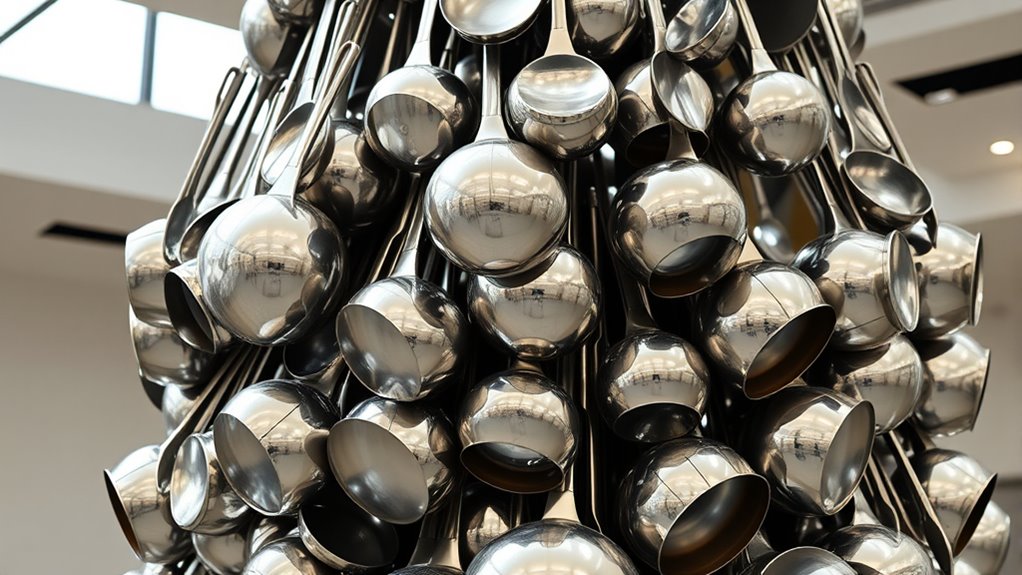
You see how Gupta uses recycled household items like pots and lunchboxes to craft powerful sculptures that challenge everyday perceptions. By transforming stainless steel and mixed media materials, he elevates ordinary objects into symbols of cultural and social significance. This approach reveals how simple techniques can turn the mundane into compelling art with deep meaning. Additionally, understanding self-watering plant pots showcases how functional design can also serve as a form of creative expression.
Recycled Household Items
Subodh Gupta transforms everyday household objects into compelling art by repurposing common items such as steel pots, pans, and tiffin boxes. He sources these objects from families across India, capturing their dents and scratches, which tell stories of use and history. These familiar items evoke memories of rural life and traditional rituals, making his work resonate emotionally and culturally. By recycling and upcycling, Gupta reduces waste and emphasizes the significance of routine objects. He welds, stacks, and arranges hundreds of utensils into large-scale installations that highlight their textures and patterns. Additionally, his work exemplifies the principles of ethical hacking, such as identifying vulnerabilities in systems to improve security. This approach underscores the importance of cybersecurity measures in protecting sensitive information.
Stainless Steel Symbolism
Stainless steel objects in Gupta’s art serve as powerful symbols of everyday life and industrialization. These utensils represent Indian domestic routines, found across all social classes, and evoke nostalgia for childhood and home. To Indian viewers, they are familiar, mundane items, but to Western audiences, they symbolize exotic cultural elements. Their reflective surfaces dazzle viewers, encouraging contemplation of daily existence and economic change. Gupta assembles these mass-produced objects into large sculptures using welding and stacking, preserving their original shapes and textures. This process highlights both their industrial origin and personal histories through scratches and dents. Stainless steel embodies mass consumption and modernization, acting as a metaphor for India’s rapid growth, while inviting viewers to see themselves within the cultural dialogue of transformation and identity.
Mixed Media Techniques
Mixed media techniques allow artists to transform ordinary objects into powerful artistic statements by combining diverse materials and methods. You can see how Subodh Gupta uses materials like steel, bronze, marble, and paint to craft compelling works. By incorporating film, video, performance, and installation, he broadens the narrative, exploring themes like cultural translation, dislocation, and globalization.
Here’s what you should look for:
- The use of found objects with stories, which carry traces of previous owners and cultural significance.
- Techniques like welding and assembly to create sculptures from everyday items, or large-scale installations.
- The blending of media—performance, video, and sculpture—to deepen the conceptual message and evoke emotional responses.
Themes of Cultural and Social Change

Gupta’s art vividly illustrates how everyday objects serve as powerful symbols of cultural and social change in India. You see, he uses items like steel tiffin boxes, thali pans, bicycles, and milk pails to represent Indian identity. To Indians, these are common, but Western audiences often see them as exotic symbols, bridging cultural gaps. His sculptures reflect India’s economic shifts, showing both poverty and prosperity across social layers. The wear and marks on these objects evoke personal and collective histories, transforming them into “pieces of the cosmos” that tell stories of migration, aspiration, and struggle. Gupta’s work highlights how rapid growth impacts society, blending tradition with modernity, and revealing the ongoing cultural and social transformation shaping contemporary India.
Notable Exhibitions and Global Recognition
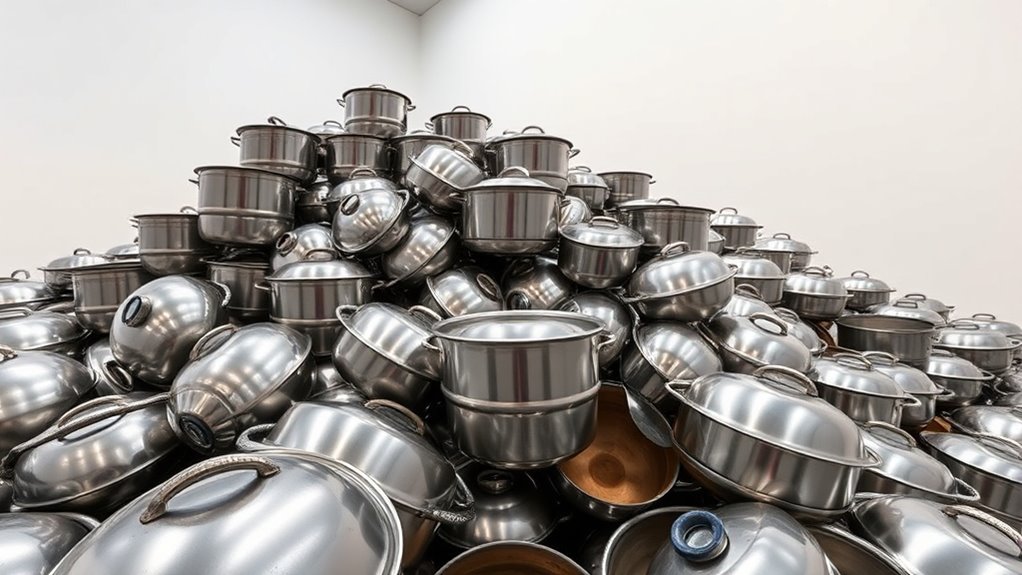
Subodh Gupta has gained international recognition through a series of prominent exhibitions that showcase his innovative use of everyday objects. His work has been displayed at major venues, cementing his reputation globally. Here are some key highlights:
- Venice Biennale (2007): Featured his monumental “Very Hungry God,” made from kitchen vessels, which was later acquired by François Pinault.
- Centre Pompidou: Exhibited his works, demonstrating his influence in contemporary art circles.
- Victoria and Albert Museum: Showcased his pieces at this prestigious London institution.
His art has received critical acclaim for blending Indian symbolism with modern themes, making Gupta a global icon. His exhibitions have attracted major collectors and further established his role in the international art scene.
Impact on Contemporary Indian Art Scene

By integrating everyday Indian objects into high art, Gupta has fundamentally reshaped the contemporary Indian art scene, making it more diverse and accessible. His use of familiar items like kitchen utensils and tiffin boxes highlights cultural heritage while addressing themes like industrialization and consumerism. This approach displaces objects from their utility, transforming them into powerful symbols that reflect societal issues. Gupta’s work shifts the narrative from traditional forms to a modern, global discourse, fostering a new understanding of Indian identity. His success has elevated the profile of Indian contemporary art internationally, inspiring other artists and expanding the collector base. As a mentor and cultural ambassador, he promotes innovation and cross-disciplinary collaboration, broadening the scope of India’s art landscape and encouraging wider acceptance of contemporary practices.
The Legacy and Future of Gupta’s Work
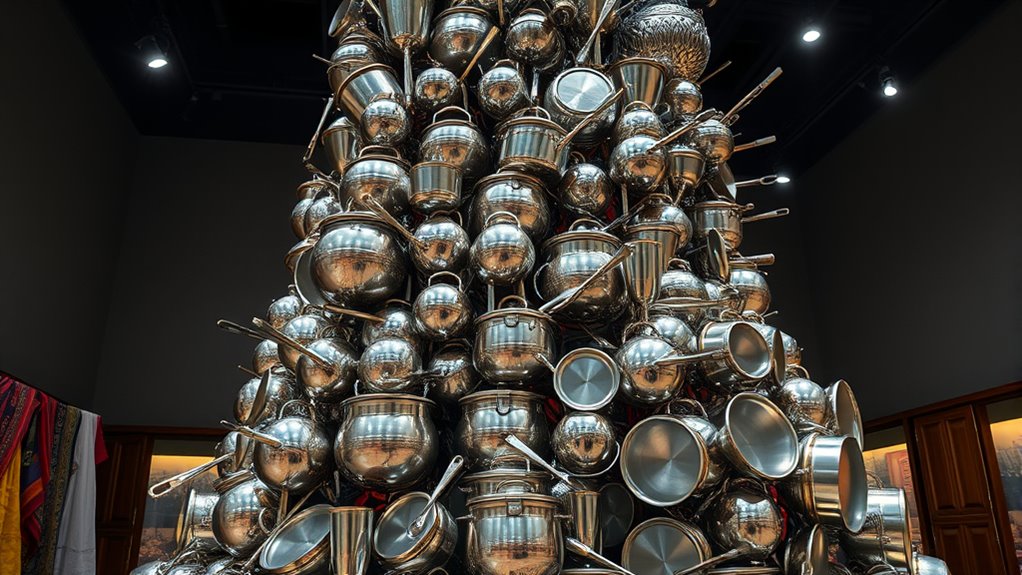
The impact of Gupta’s innovative approach continues to resonate within the global art world, shaping the future of contemporary Indian art. You’ll see his legacy in how he elevates everyday objects to fine art, challenging traditional hierarchies. His work’s international recognition, including sales surpassing $1 million and France’s Chevalier dans l’Ordre des Arts et des Lettres, cements his influence. Retrospectives at major institutions, like the National Gallery of Modern Art, document his milestones and inspire emerging artists. Moving forward, Gupta’s practice will likely expand into digital media, eco-conscious materials, and global collaborations. His ability to bridge rural Indian life with contemporary issues ensures his work remains relevant and influential. His legacy shapes future dialogues around culture, identity, and social commentary in art.
Frequently Asked Questions
How Does Gupta Select Everyday Objects for His Artworks?
You choose everyday objects that hold cultural, social, or personal significance, reflecting Indian life and traditions. These items, like tiffin boxes or milk pails, evoke memories or symbolize common experiences across classes. You often select objects with marks of wear, telling stories of lives lived. By transforming these items into art, you explore their deeper meanings, connecting personal memories with broader cultural narratives.
What Inspires Gupta’S Use of Stainless Steel in His Sculptures?
Imagine you’re in the 21st century, surrounded by shiny stainless steel. Gupta’s inspired by its durability and reflective qualities, which echo modern India’s industrial growth. You see everyday utensils transformed into art, linking tradition with modernity. The material’s industrial feel contrasts with its cultural significance, representing migration, social change, and globalization. This blend of the familiar and the contemporary fuels his creative choice, making ordinary objects extraordinary through stainless steel’s visual and symbolic power.
How Does Gupta’S Work Reflect India’S Socio-Economic Transformations?
You see that his work captures India’s socio-economic shifts by transforming everyday objects into powerful symbols. By incorporating items like bicycles, cow dung, and food containers, he highlights rural-to-urban migration, economic growth, and cultural identity. His art reflects modernization and globalization, emphasizing both progress and disparities. Through innovative techniques and large-scale installations, he invites you to explore India’s evolving social landscape and the complex interplay of tradition and modernity.
What Role Does Humor Play in Gupta’S Artistic Narratives?
Humor helps Gupta’s art connect with you by turning ordinary objects into playful sculptures, making everyday life feel extraordinary. It invites you to see the absurd and humorous side of routine, breaking down complex social issues into relatable visuals. By using humor, Gupta makes his messages more accessible and engaging, encouraging you to reflect on societal norms while enjoying the lighthearted surprise of familiar items transformed into art.
How Has Gupta Influenced Emerging Indian Contemporary Artists?
Imagine scrolling through Instagram and discovering fresh Indian artists reshaping contemporary art. Gupta’s influence inspires you to experiment with diverse mediums, blending traditional symbols with modern themes. His success proves that even mundane objects can turn into powerful art, encouraging you to explore local narratives. Mentorship from artists like Gupta helps you develop your unique voice, fostering confidence to push boundaries and gain international recognition in India’s thriving art scene.
Conclusion
You might be surprised to learn that over 80% of Gupta’s artworks incorporate everyday objects, transforming the mundane into extraordinary art. His innovative approach challenges you to see the familiar differently, inspiring a deeper appreciation for India’s cultural fabric. As you follow his journey, remember that his work has not only gained international recognition but also influenced countless contemporary artists. Gupta’s legacy proves that even the simplest objects can hold profound artistic and social significance.





